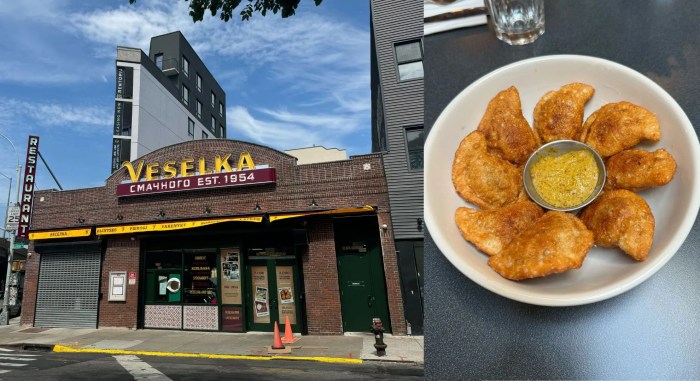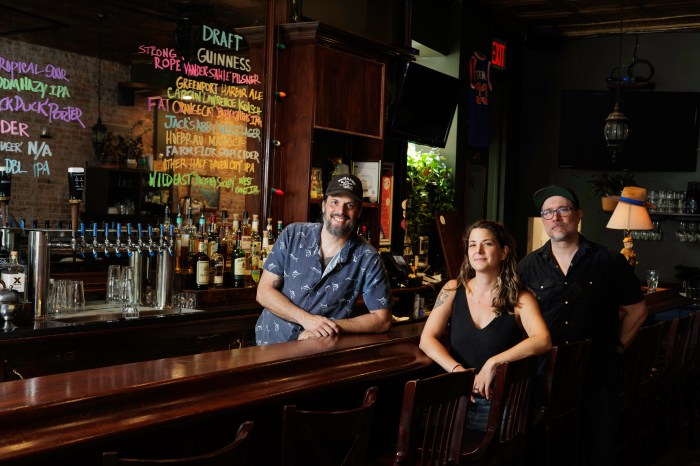Brooklynites looking to cool down with a sweet treat this summer will find two shops focused on one thing: building a better ice cream.
On one hand, there’s Ample Hills’ hand-crafted approach, applying good-ole-fashion blood, sweat, and tears into their imaginative ice cream, and on the other hand there’s Blue Marble’s strict adherence to industry standards for organic foods.
“Ultimately, there’s not a secret recipe to ice cream,” said Brian Smith, owner of Ample Hills Creamery. “It’s milk, cream, sugar and some people use egg yolks like we do. The real secret is quality of ingredients, like in most cooking.”
Though clearly, it’s not that simple.
Ample Hills relies heavily on authentic flavors and ingredients — such as adding authentic St. Louis Ooey Gooey Butter Cake pieces to their creamy vanilla — to satisfy people’s taste buds. Not only does Smith create the ice cream from fresh, local ingredients (the milk, cream and eggs all come from New York farms) right in the store, but he also focuses on flavoring the ice cream with real foods. He concocts the store’s new cinnamon toast soft serve from what he calls “the actual essence of toast” by toasting bread in the oven, steeping it in the ice cream, straining out the bread, and adding cinnamon and other spices. Smith goes through this process of extracting flavors and infusing them into ice cream for a lot of flavors, creating ice cream that tastes like pretzels or marshmallows.
A sci-fi screenwriter turned ice cream guru, the creativity and story of ice cream mean a lot to Smith; how he crafts the ice cream matters just as much as the final product. From the pasteurization of the dairy to the mixing in of pretzels, homemade cookies, cereal, spices and any other ingredients, everything is done in plain sight. Signs hang around the windows of the production area, narrating and explaining the entire process of how the ice cream comes to be. As Smith puts it, “It’s all there at Ample Hills.”
“We make everything that everybody eats when they’re at Ample Hills. People can learn how we make ice cream,” said Smith. “That connection to the origin of it, to the story, is important and people respond to that.”
He even does the pasteurization on-site, never using the dairy mix other ice cream makers use in order to give the ice cream a longer shelf life.
“The flavor of our sweet cream base is creamier and more flavorful,” said Smith. “They [other dairy manufacturers] are cooking off more of the flavor. It allows us to make a fresher, cleaner better tasting product.”
While Ample Hills isn’t far from the organic product Brooklynites look for, Blue Marble is the only USDA certified-organic ice cream store in all of New York. Achieving USDA organic certification means following rigid rules of what can and cannot be put in the ice cream. That means no growth hormones, no genetically modified ingredients, or ingredients treated with pesticides. Most importantly for ice cream, the dairy cows must only eat organic feed.
But with all these bells and whistles, is ice cream ever good for you?
Kathleen Axen, a health and nutrition professor at Brooklyn College, said when it comes to the cold dessert, eat up and enjoy — in moderation.
“I don’t think of ice cream being inherently unhealthy,” said Axen.
“It’s just a fine food. It’s about the amount of it that people are consuming. I wouldn’t label it a junk food.”
Ample Hills [623 Vanderbilt Ave. at St. Marks Avenue, (347) 240–3926, www.amplehills.com], Blue Marble [186 Underhill Ave. between Sterling and St. Johns places, (718) 399-6926].






















